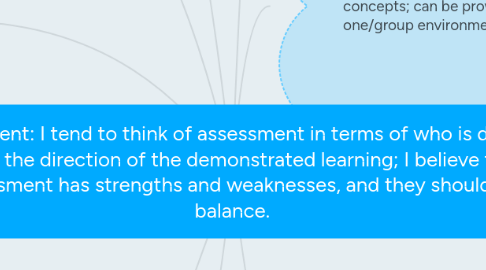
1. Formative vs. Summative Assessment
1.1. A site that details the differences between F & S Assessment
1.2. Formative Assessment: Low pressure methods that check students' understanding of specific concepts and content
1.3. Summative Assessment: A more cumulative check of students' knowledge and skill set that can be used to continue into the next lesson. Higher stakes.
2. District-directed
2.1. Standardized testing
2.2. IEPs
3. Textbook/Worksheet-directed: Good for continuous assessment, not for cumulative assessment.
3.1. Written homework
3.2. End of chapter questions
3.3. Reading passages
4. Parent-directed
4.1. Observations outside of school
5. Designing Assessment into the Curriculum
5.1. Backwards Design: I wrote an article about this for my blog a while back click arrow to go there.
6. IB Assessment Philosophy
6.1. Programme evaluation: Student assessments should be done in terms of the programme's standards and practices to determine programme effectiveness.
6.2. Be critical of the assessment methods!
6.2.1. Students must be clear about what they are expected to understand and demonstrate.
6.2.2. Consider what the student's performance indicates about their understanding.
7. Three Steps of Assessment
7.1. Assessing
7.1.1. How do we check student understanding?
7.1.1.1. Set the expected performance standards before assessment; students should be clear about them
7.1.1.2. Students should do self-reflection
7.1.1.3. Allow for expression of various learning styles & points of view to show understanding
7.2. Recording
7.2.1. What are the best strategies and tools to use to check this area of understanding?
7.2.1.1. Strategies: - Observations - Performance Assessments - Process-focused assessments - Selected responses - Open-ended tasks
7.2.1.2. Tools: - Rubrics - Exemplars - Checklists - Anecdotal Records - Continuums
7.2.1.3. Documentation: - Portfolios (should contain work that demonstrates the process of learning)
7.3. Reporting
7.3.1. How do we explain the results of the assessments?
7.3.1.1. Conferences: - Teacher-Student - Teacher-Parents - Student-led (involves prep and student practice) - Teacher-Student-Parent
7.3.1.2. Written Reports/Report Cards
7.3.1.3. Exhibition (Final Year of PYP)
8. Teacher-directed: Can be focused to specific skills and concepts; can be provided in a semi-controlled, one on one/group environment.
8.1. Literacy Assessment
8.1.1. Cloze testing
8.1.2. Running Records
8.1.3. Reading Rounds
8.2. In-class testing
8.2.1. Math speed tests
8.2.2. End of unit tests
8.3. Teacher-Student Interviews
8.4. Asking questions/Calling on Students
8.5. General classroom observations
9. Student-directed: Most demonstrative of skills and concepts that the students have absorbed and are able to use in regular practice.
9.1. Presentations/Projects
9.1.1. Oral
9.1.2. Posters
9.1.3. Art
9.2. Group projects
9.2.1. Student-directed Inquiry
